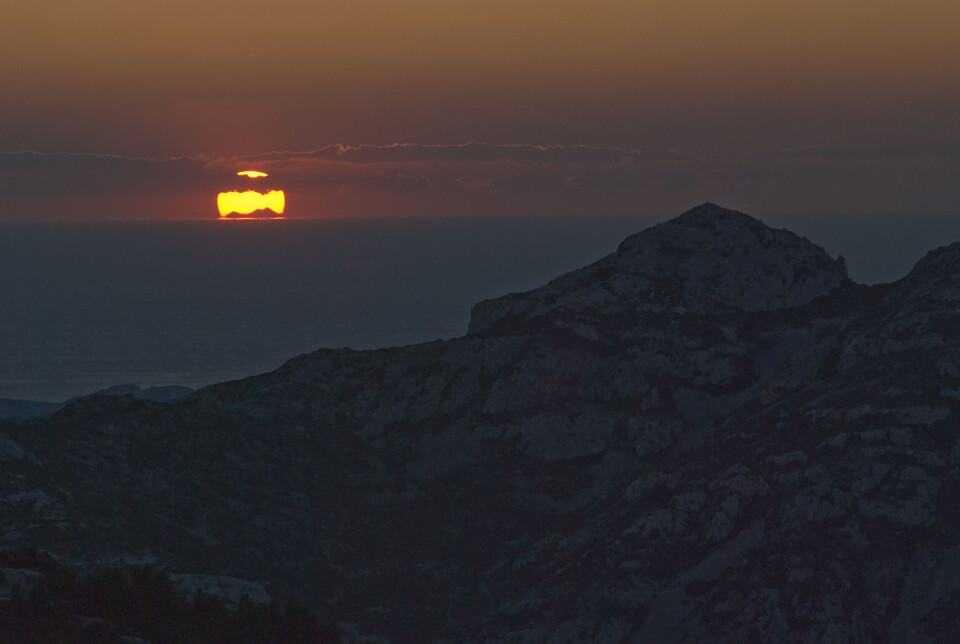-
French ski resorts report excellent Christmas despite less snow than last year
Bookings are up and non-snow related activities are also on the rise
-
Snow to hit Pyrénées this week bringing optimism to ski resorts
More than 20cm is expected at the highest peaks in mountain chain
-
Winter tyre rules mandatory in French mountain areas from November
See which departments require the tyres and which only partially apply the law
PHOTOS: See the Pyrenees… from Marseille
The mountains are visible from over 250 kilometres away from observation points

A rare phenomenon means that the Pyrenees can be seen from the south-eastern coast of France, over 250 kilometres away, on certain days of the year.
It occurs due to the way that the sun aligns with the peaks of the Pyrenees when it sets and rises and the effect of the atmosphere on light and can happen between the start of November and the end of February.
Alain Origné, 73, a retired research engineer for the CRNS (National Centre for Scientific Research) at the Astrophysics Laboratory of Marseille, has compiled a list of observation points and dates when the phenomenon is visible, which you can find on his website here.
For example, it is visible near Marseille around February 15 and near Toulon until February 22. If you decide to go to one of these observation points, make sure to look up how to get there first: a couple of them require two hours of hiking.
First observed in 1808
The phenomenon has been known for a long time in Marseille, said Mr Origné, although it was believed to be a disappearing island. As local fishermen knew that such an island did not exist, it was either thought to be some sort of mirage or a practical joke.
At the beginning of the 19th century, an Austrian astronomer, Baron Franz Xaver von Zach, came to work in Marseille.
He heard about the sighting of a mysterious island in the south west from residents, and, being a talented geographer, worked out that it could only be the Pyrenees, located around 250 kilometres away.
On February 8, 1808, he and several witnesses went up to the highest point in Marseille (the fort on the colline de la Garde, now the location for a basilica), around 150 metres above sea-level, and recorded the first scientific observation of the Pyrenees from Marseille, thereby confirming the phenomenon.
He then wrote about the observation in a book.

With no photographic evidence, scholars at the time performed calculations and concluded that it was not possible to see the Pyrenees from 250 kilometres away due to the curvature of the Earth, but we know now that Baron von Zach was indeed correct.
The effects of atmosphere on light
The reason the scholars at the time did not believe Baron von Zach is because the optical effects of the atmosphere were not yet known.
Later, scientists discovered that differences in atmospheric pressure due to altitude can make light waves curve.
This curvature is “possible on huge distances, which is the case with this phenomenon,” said Mr Origné.
It is only observable from specific vantage points at specific times between November and February because of the alignment of the sun with the Pyrenees peaks.
The sun is directly behind the peaks such as Canigou and Puig Sec from the points Mr Origné has compiled on the dates he has listed, which makes them visible against the solar disk.
He notes that it is a “unique” and “rare” phenomenon. He has searched for other, similar phenomena but none match the great distance and curvature of this one, which directly invokes the effect of the atmosphere.

The atmosphere can also affect the shape of a setting sun and can create mirages.
It acts as a filter too, which is why the Moon and a setting or rising sun appear redder when they are near the horizon compared to when they are higher in the sky.
Twenty years of personal research
Mr Origné is not an astronomer but had a passion that led to him being interested in the phenomenon, which has so far lasted over 20 years.
Working at the Astrophysics Laboratory of Marseille, he had access to certain documents that fueled his personal research into what was long thought of as a practical joke.
He created a blog and a website many years ago with the dates and locations along the French coast that people could observe the Pyrenees from.
He did so because he found that word of mouth was not accurate and wanted as many people as possible to be able to witness the incredible sight.
He has now written a book about the occurrence, where he talks about its history and details where it can be seen. He was asked to write it by the ‘syndicat mixte Canigó Grand Site’, a syndicate charged with the defence and the promotion of the Canigou Massif.
It is written in French on the left side and translated into Catalan on the right. For Catalonians, Canigou is an important, “almost sacred” site and its importance extends far into both Spain and France, hence why he was asked to write the book.
The book is not yet available in English but you can buy it here. It includes many photos of the phenomenon.
Mr Origné’s website, which you can find here, is also in French but most Internet browsers offer the option of directly translating websites.
Read more
PHOTOS: Northern Lights captured over France
‘Enchanted’, ‘amazing’: Your memories of the Perseids shooting stars
























